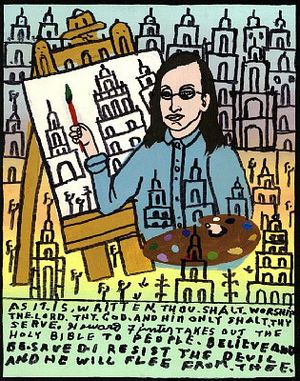Howard Finster facts for kids
Quick facts for kids
Howard Finster
|
|
|---|---|
 |
|
| Born | December 2, 1916 |
| Died | October 22, 2001 (aged 84) |
| Movement | Folk art, Outsider art |
Howard Finster (born December 2, 1916 – died October 22, 2001) was an American artist and a Baptist minister. He was from Georgia. Howard Finster believed God inspired him to share messages through his art. He transformed his land into a special place called Paradise Garden. This garden was filled with over 46,000 pieces of unique art.
His art is known as outsider art, naïve art, and visionary art. Finster became widely known in the 1980s. He designed album covers for famous bands like R.E.M. and Talking Heads.
Contents
Early Life and Calling
Howard Finster was born in Valley Head, Alabama. He was one of 13 children in his family. He lived on the family farm and went to school until the sixth grade.
Howard Finster's First Vision
Finster said he had his first special vision when he was only three years old. He saw his sister, Abbie Rose, who had recently passed away. She appeared to him in a white gown and told him, "Howard, you're gonna be a man of visions." This experience shaped his life.
Becoming a Minister
When he was 13, Finster became a "born again" Christian. He started preaching at age 16. He gave sermons in local churches. He also wrote articles for the town newspaper. In 1940, he became a full-time pastor. He served at Rock Bridge Baptist Church. Later, he worked at Mount Carmel Baptist Church. After this, he decided to focus on his art full-time.
Creating Art and Paradise Garden
Howard Finster began building his first garden museum in Trion, Georgia. This was in the late 1940s. He wanted to show "the inventions of mankind." He planned to display models of houses and churches. He also had a pigeon flock and a duck pond.
In 1961, he needed more space. He moved to Pennville, Georgia, near Summerville. He bought four acres of land. Here, he built the Plant Farm Museum. He wanted it to be like the Garden of Eden. It was a place to show "all the wonderful things o' God's Creation."
What Can You See at Paradise Garden?
The Plant Farm Museum, later known as Paradise Garden, has many interesting parts. These include the "Bible House" and the "Mirror House." There is also the "Hubcap Tower" and the "Bicycle Tower." The largest building is the five-story "Folk Art Chapel." Finster also put up signs with Bible verses. He felt these messages would "stick in people's heads better."
The Vision to Paint Sacred Art
Finster stopped preaching in 1965. He then spent all his time on the Plant Farm Museum. In 1976, he had another important vision. He felt called to paint sacred art. He described how he was fixing a bicycle. He saw a human face on his finger. Then, a warm feeling came over him. A voice told him, "Paint sacred art."
Finster painted many different things. His art included pop culture figures like Elvis Presley. He also painted historical figures like George Washington and Ronald Reagan. Religious images, UFOs, aliens, war, and politics were also subjects. His paintings are very colorful and detailed. They often have words, especially Bible verses. Each painting also has a number. God had asked him to create 5,000 paintings to share his message. Finster wanted to keep track.
He finished his 5,000th painting in 1985. But he kept painting and numbering his works until he passed away. By 1989, he had already created tens of thousands of pieces.
Finster's Fame and Influence
Howard Finster started getting public attention in 1975. A TV station in Atlanta, WAGA, did a story about him. He also appeared in an Esquire magazine article. This article first called his museum Paradise Garden.
He had his first art exhibition in 1976. In 1977, he painted four pieces for the Library of Congress. He was also chosen to be part of the Venice Biennale in 1984. Several of Finster's artworks are now displayed at the Smithsonian American Art Museum in Washington, D.C.
Working with Music Stars
Finster became nationally famous because of his work with the rock band R.E.M.. The band filmed their music video for "Radio Free Europe" in Paradise Gardens in 1983. The next year, R.E.M.'s singer, Michael Stipe, and Finster worked together. They created a painting for the cover of R.E.M.'s album Reckoning. R.E.M. later made a song called "Maps and Legends" as a tribute to Finster.
Finster also appeared in a documentary film called Athens, GA: Inside Out. In this film, he shared his story of becoming an artist. The band Talking Heads also asked Finster to create a painting. This painting was for their album Little Creatures in 1985. Rolling Stone magazine chose it as the album cover of the year. Other artists also used Finster's designs for their album covers.
Finster's Legacy
In 1994, a part of his Paradise Garden became a permanent display. It was installed at Atlanta's High Museum. Howard Finster helped introduce many people to outsider art. Even with his fame, he always focused on sharing his religious messages. He once said about the Talking Heads album, "I think there's twenty-six religious verses on that first cover I done for them. They sold a million records in the first two and a half months after it come out, so that's twenty-six million verses I got out into the world in two and a half months!"
His art is often called folk art or outsider art because of his background. It is also known as naïve art and visionary art due to its unique content and style.



